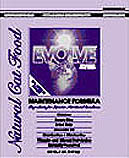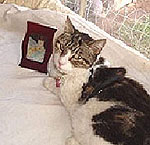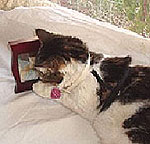Vol. 2, No. 20
Table of Contents
Feline Nutrition: What’s for Supper, Hon
Assist Feeding: The BEST News EVER!
Kitty Potpourri:High-Tech Kitty Locators
Best Cat Food: Evolve Natural Pet Foods
Caring for Cats: Not Really Gone…
Feline Nutrition
What’s For Supper, Hon?
by Garry White
“Leftovers; they’ve only been in the Fridge for a week or so.”
Unusual week, folks. Here in Feline Nutrition, we’ll respond to some excellent feedback from one of our readers; a lady named “Cat” from Phoenix. She’s originally from France, and I think Cat is short for Caterina, or hopefully something close to that. Cat and I go back a ways to the time when my Lewie was sick with CRF and throughout his passing, and we have an almost unbelievable story that I’ll share with you below in Caring For Cats.
But here, let’s address a recent message I got from her, regarding confusion about food spoilage. In the past few newsletters, we discussed how temperature affects the growth-rate of common food-borne bacteria, such as E. Coli and Salmonella. Well, leave it to a reader to capture the only thing I didn’t talk about! Her own words: “Here is a question for you. Mishka gets his special can food and he eats very little of it. I am careful not to let it out long and keep it refrigerated. My question is how long can a can food keep in the refrigerator? Since he does not eat much, there is always left over. I do not keep it more than 2 days. What is your insight on this?”
It’s a valid question, Cat, and one that I should have covered earlier. We face a couple of dragons with this question: First would be that we’ve all committed the big sin…forgot to pick up the food plate, it sat out overnight in warm weather, Kitty ate it and Kitty didn’t die or even get sick, so there’s our evidence that it’s all bunk! Not really. Unlike humans, cats have a very short digestive tract, which means that everything…including bacteria…passes through a little quicker. That is to say, it does if everything is working well and all systems are at peak performance. Take an older cat, or one with an ailment you aren’t aware of yet, or one who’s just having an off-day, and the risk-factors go through the roof…the digestive system operates much slower than normal, and those nasty bugs will hang around long enough to do serious damage. Second…food is not cheap, and it’s hard to toss an almost-untouched plate of food in the trash, even though it has been sitting out for an hour.
Here are the numbers on this issue, and I’ll leave you to deal with them as you see fit: The books say that E. Coli and Salmonella bacteria reproduce the entire colonies at a rate of 25% in 24 hours in temperatures of 34-38 degrees F… Fridge temp. That means an opened (but sealed from the air) can of food should last for 4 days in the Fridge. At room temperature, things change in a hurry: The bacterial growth rate increases to 20% per hour!
Again, these are numbers that could be challenged by any of us, but they’re based on science and I live by them.
To offset this dilemma of throwing out most of a can of food in the trash, I set out smaller portions, and I practice a routine that I’ve suggested on here several times…I set their food-plate in a bowl of ice cubes. And I never, ever serve leftovers that are more than 3 days old. Yes, I mark the can, and so should you. As for Fridg’ing stuff, I went nuts transferring foods into non-plastic containers and trying to find a cover that would seal the cans well…and then an idea came to me: Cheap sandwich bags and rubber bands! Slip the whole can in the bag, r/b it, and it’s airtight!
Assist Feeding
The best new. EVER.
by Kathy Fatheree
BERT ATE! BERT ATE!!!
(can you tell how excited I am?!) We have been following a feeding plan from our vet. The plan is one that most people would object to, but at this point we trust Dr. Smith implicitly.
The Plan
What Dr. Smith had us do is replace one of Bert’s meals with warm water. Essentially cutting his calories per day in half (we were feeding him twice a day, the same amount each time).
Dr. Smith’s Logic
Bert would still be getting that feeding that he loved so much but not getting the satisfaction from it. Bert would digest the water rapidly and feel hungry soon after. This is a method that he’s been using on other patients and apparently has worked every time. In fact (and I think I told you about this kitty) it worked so well with one of his patients that the darn kitty pulled his own feeding tube out!! He got sick of it because he wasn’t being fed through it anymore and out he pulled it! He’s doing fine but it was pretty serious I guess.
Results
We started seeing results as soon as we switched Bert’s morning meal to water. He began to get very dissatisfied with his feedings. He was restless and wouldn’t sit still. He was flicking his tail at us and being pretty vocal. After a few days of this we decided to try to get Bert to eat a little A/D. We put it down for him and he sat in front of the plate just looking at the food. He didn’t touch it but he kept coming back to it over and over and just sitting there. Next, we got a different type of hard food. We went with Cat Chow because that’s what he ate before his Eukanuba. When we put it in front of him he kept putting his head down in the bowl and smelling it. He would just hover above the bowl but didn’t eat anything. We waited another few days and when we were grocery shopping this weekend we grabbed some 9 lives hard food. As soon as we put it down in front of Bert he tried to eat a piece! We about passed out!! He couldn’t get the hang of it and got discouraged. One reason, we were thinking, that he walked away is because he had had his evening feeding only a few hours before. So we picked it up and waited until Monday morning to try again (at his normal 6 am feeding). No sooner had we set the food down did he take a bite!! He seemed to be having issues with the hardness of it. He wasn’t crunching it all the way, more gumming it until it was moist and then crunching it. I called the vet’s office and they said that is normal… That after six months his gums and teeth might be a little tender!
Be sure to check in next week to see if Bert is still eating…
Kitty Potpourri
‘High-Tech’ Kitty Locators
by Dan Malenski
This week, we will give you an update on the latest high-tech products on the market for use in locating out cats that stray from home and cause us untold amounts of worry. We will also introduce an exciting new product on the market that works in an entirely different way and is only limited by the creativity of the user.
Collars are still the easiest method of identifying a lost kitty, but not all cats wear collars for various reasons, which we will not discuss here and tattoos are not foolproof either. Only a few years ago, the microchip was introduced, which is an electronic device no larger than a grain of rice that is injected beneath the skin behind the shoulder blades of the cat (or d*g). At that time, acceptance was not great due to compatibility problems between the scanners and microchips of competing companies and the fact that the imbedded microchip was of no use if the facility trying to identity the animal did not have a scanner. Acceptance of the product had greatly improved over the years due to the advent of universal scanners and the manufacture’s practice of providing veterinarians and shelters with the scanners.
behind the shoulder blades of the cat (or d*g). At that time, acceptance was not great due to compatibility problems between the scanners and microchips of competing companies and the fact that the imbedded microchip was of no use if the facility trying to identity the animal did not have a scanner. Acceptance of the product had greatly improved over the years due to the advent of universal scanners and the manufacture’s practice of providing veterinarians and shelters with the scanners.
At the present time, there are only two companies in the U.S. marketing microchips, and they are Schering-Plough (Home Again™) and Avid Identification Systems. They are very similar as they function the same way, although Schering claims that their product contains an anti-migration cap that prevents an imbedded microchip from migrating to a different area of the body. For those not familiar with the microchip product, the scanner merely picks up a programmed number  from the implanted microchip that is registered to the veterinarian who implanted the microchip,the owner, or both. The product may be registered or changes made via postal mail, telephone, or the internet. The photo in this paragraph is that of the hand-held scanner.
from the implanted microchip that is registered to the veterinarian who implanted the microchip,the owner, or both. The product may be registered or changes made via postal mail, telephone, or the internet. The photo in this paragraph is that of the hand-held scanner.
For those considering the use of this product, be sure to insure that your veterinarian does not use any of the European brands, as the U.S. manufactured scanners will not recognize them. Be aware, however, that European scanners will recognize the Home Again™ product for those kitties who insist that their companions take them along on their next trip to Paris. We also recommend that you contact your local shelter to insure that they do possess a scanner-and use it!
Where’s kitty?
How many times have we uttered these words when preparing to take kitty to the vet for treatment of an illness or just a routine checkup. We all know that cats have a sixth sense that tells them when they should vanish into the woodwork. They don’t even have to see that dreaded carrier-they just know! Fortunately, for us humans who seemed to be constantly outfoxed by these clever felines, there is a new high-tech product on the market designed to help even the odds.
Unlike the microchip, which must be scanned for its identification code, this product consists of a transmitter affixed to a collar that is very similar to those devices hidden in vehicles, boats, and aircraft that emits a signal that is used to home in on by a receiver. The receiver has an antenna attached to it, which guides the user to the source of the signal. The transmitting device has the same limitations of the collar and  although the range in open country is over a mile, it is only a block or two in a populated area due to building interference; however, this range is sure to improve as the technology advances. For those interested in the details of this product, you may visit the manufacture’s web site at:
although the range in open country is over a mile, it is only a block or two in a populated area due to building interference; however, this range is sure to improve as the technology advances. For those interested in the details of this product, you may visit the manufacture’s web site at:
http://www.thecatlocator.com
Of course, this product may be used to track animals other than cats, and its use is limited only by your imagination. Amanda, who has been very quiet lately, suggested the product not be used for animals at all, but suggested that the transmitter be removed from the collar and dropped into the pocket of a spouse that has the tendency to stray from the home front from time to time. >^..^<
Best Cat Food
Evolve Natural Pet Foods
by Garry White
Each week we are having our own cat food reviews to determine what we, or should I say, our kitties think is the best cat food.

Brand Name: Evolve Natural Pet Foods
Product: ‘Maintenance Formula’
Type: Dry
Our Rating: ![]()
Kitty Rating: ![]()
Kitty Comments:
“Hmmm…haven’t I seen this bag sitting in our drawer for a while?”
Our Comments:
“You have, Clarkie; I’ve been holding out on you. Please find it in your heart to forgive me.” Actually, I hadn’t gotten around to testing this one yet, but the boy is a control-freak with sharp claws…sometimes it’s simpler (and safer) to just be humble. Anyway, I’m probably in trouble with Harvey and the folks from Evolve, too; we tested this food just yesterday, and there wasn’t time to give Harvey a chance to talk with us, so while my guys are enjoying this wholesome and nutritious food, I’ll be nibbling on some Humble Pie. But those are semantics, and it’s really all about presenting a great, new food, right? Which means that all my sins should be overlooked because this Maintenance Formula is excellent in every way! First off, the ingredient-list is more than impressive, and includes a variety of nutritional treasures like: Dried Kelp, Avocado Oil, Cranberries, Blueberries, Menhaden Flounder, Flax-Seed Oil, and the list goes on. Everything we really want in a great cat food is in this little bag! Plus, my guys seemed to like the taste, and I bet yours will, too. Give it a try, folks; I heartily endorse Evolve as a quality, caring company, and I have no qualms at all recommending the Maintenance Formula.
Website: http://www.evolvepet.com/catfoodgi.html
Phone: 1-800-331-5144

Caring for Cats
Not Really Gone…
by Garry White
Upstairs in Feline Nutrition, I mentioned a lady from Phoenix named…appropriately…Cat. Cat and I go back to the days when my Lewie was first diagnosed with CRF, and we’ve maintained a good friendship since then. Anyway, most of you readers know that CRF ultimately won the battle, and I did what most of us do after such a loss; I donated Lewie’s supplies to needy folks with sick cats. Cat notified me that she’d be interested in some of Lewie’s things, and you should know a few things about this lady before I proceed: She is a superb humanitarian, a wonderful person who works two (sometimes three!) jobs, and in her spare time captures, cares for, and places, feral cats. Moving along with the story: At the time, Cat had a very sick kitty named Katie who desperately needed some of the supplies I’d accumulated for Lewie. It was probably pointless, she said, because the vets had sent Katie home to die…nothing else they could do; she had maybe a few days to live, at most. No matter, Cat wasn’t willing to give up and neither was I.
So I sent the requested supplies, along with a small, framed picture of Lewie as a memento. The supplies arrived in Phoenix, and I get a call from Cat, with dialogue that went something like this: “Wow, Garry, the craziest thing has happened. I showed Lewie’s picture to Katie, and she flipped! She perked up immediately, cuddled up against Lewie’s picture, started kissing it, and will not leave it alone!” Naturally, I assumed Cat was just being nice because of the supplies. But that wasn’t the case at all: The following morning in my email were several pictures of Katie and Lewie’s picture, which made me flip! As the days and weeks went on, I got more and more stories about the mystery relationship between Katie and Lewie. Katie actually improved in spite of her disease and prognosis, and Cat said that Katie would not go anywhere without Lewie’s picture! Katie lived on for a time, and with a little coaxing, maybe we can get Cat to tell Katie’s story.


Disclaimer: Kathy Fatheree is not at all a medical expert. Contents of this web site are a collection of Kathy’s assist feeding experiences as well as the experiences of other cat owners who have assist fed their cats. While every effort has been made to ensure the accuracy of the information, Kathy Fatheree or anyone associated with this web site cannot be held responsible for anything that may happen as a result of using the information on this site.
